Assessing the Urban Heat Island (UHI) Effect Using Land Surface Temperature (LST) and Normalized Difference Built-Up Index (NDBI): A Case Study on Paphos, Cyprus †
Abstract
1. Introduction
1.1. Remote Sensing and Urbanization
1.2. Urban Expansion
2. Methodology
2.1. Normalized Difference Built-Up Index (NDBI)
2.2. Normalized Difference Vegetation Index (NDVI)
2.3. Data and Methodology
3. Results
4. Conclusions
Author Contributions
Funding
Institutional Review Board Statement
Informed Consent Statement
Data Availability Statement
Acknowledgments
Conflicts of Interest
References
- Kiara, C.; Michelle, M.; Christian, Q.; Jennifer, C.; Jose, C. Analysis of urban expansion and its relationship with climate change in Huancayo 1969–2019. In Proceedings of the E3S Web of Conferences, Tamilnadu, India, 22–23 November 2023; EDP Sciences: Les Ulis, France, 2023; pp. 249–258. [Google Scholar]
- Alcoforado, M.J.; Andrade, H. Global Warming and the Urban Heat Island. In Urban Ecology: An International Perspective on the Interaction Between Humans and Nature; Springer: Boston, MA, USA, 2008; pp. 249–262. [Google Scholar]
- Vikash, S. Urbanization Induced Climate Change: Impacts and Sustainable Solutions. Asian Res. J. Arts Soc. Sci. 2025, 5, 135–142. [Google Scholar] [CrossRef]
- Subhanil, G.; Himanshu, G.; Neetu, G.; Anindita, D. A long-term seasonal analysis on the relationship between LST and NDBI using Landsat data. Quat. Int. 2021, 575, 249–258. [Google Scholar] [CrossRef]
- Nusret, D.; Samir, D.; Muniba, O. NDVI and NDBI Indexes as Indicators of the Creation of Urban Heat Islands in the Sarajevo Basin. Geogr. Pannonica 2024, 28, 34–43. [Google Scholar] [CrossRef]
- Subhanil, G.; Himanshu, G.; Anindita, D.; Neetu, G. Analytical study of land surface temperature with NDVI and NDBI using Landsat 8 OLI and TIRS data in Florence and Naples city, Italy. Eur. J. Remote Sens. 2018, 51, 667–678. [Google Scholar]
- Zha, Y.; Gao, J.; Ni, S. Use of normalized difference built-up index in automatically mapping urban areas from TM imagery. Int. J. Remote Sens. 2003, 24, 583–594. [Google Scholar] [CrossRef]
- Mohammad, S.M.; Jai, P.S.; Satanand, M. Relationship of LST, NDBI and NDVI using Landsat-8 data in Kandaihimmat Watershed, Hoshangabad, India. Indian J. Geo Mar. Sci. 2018, 48, 25–31. [Google Scholar]
- Raihan, A.R.G.; Hamim, Z.H.; Basyar, I.A. Analysis of the Impact of Residential Land Development on LST in Semarang City. Adv. Soc. Sci. Educ. Humanit. Res. 2023, 755, 421–435. [Google Scholar]
- Halder, B.; Bandyopadhyay, J.; Khedher, K.M.; Fai, C.M.; Tangang, F.; Yaseen, Z.M. Delineation of urban expansion influences urban heat islands and natural environment using remote sensing and GIS-based in industrial area. Environ. Sci. Pollut. Res. 2022, 29, 73147–73170. [Google Scholar] [CrossRef] [PubMed]
- Muhaimin, M.; Fitriani, D.; Adyatma, S.; Arisanty, D. Mapping Build-up area density using normalized difference Built-up Index (NDBI) and Urban Index (UI) wetland in the city banjarmasin. IOP Conf. Ser. Earth Environ. Sci. (EES) 2022, 1089, 012036. [Google Scholar] [CrossRef]
- Firozjaei, M.K.; Sedighi, A.; Kiavarz, M.; Qureshi, S.; Haase, D.; Alavipanah, S.K. Automated Built-Up Extraction Index: A New Technique for Mapping Surface Built-Up Areas Using LANDSAT 8 OLI Imagery. Remote Sens. 2019, 11, 1966. [Google Scholar] [CrossRef]
- Ankush, A.; Shikha, V. Analysis of urban area extracted from NDBI and classification approach by using satellite data. In Proceedings of the 8th International Conference on Engineering and Emerging Technologies (ICEET), Kuala Lumpur, Malaysia, 26 October 2022; IEEE: New York, NY, USA, 2022. [Google Scholar]
- Nzoiwu, C.P.; Agulue, E.I.; Mbah, S.; Igboanugo, C.P. Impact of Land Use/Land Cover Change on Surface Temperature Condition of Awka Town, Nigeria. J. Geogr. Inf. Syst. 2017, 9, 763–776. [Google Scholar] [CrossRef]
- Chathuranga, M.; Sandamali, J. Time series analysis of urban temperature in Kandy city, Sri Lanka with the use of satellite remote sensing. In Proceedings of the 12th International Research Conference, Ratmalana, Sri Lanka, 11–12 September 2019; pp. 125–130. [Google Scholar]
- Bozorgi, M.; Nejadkoorki, F.; Bihamta, N. Trend analysis development of urban heat island using thermal remote sensing. Earth Obs. Geomat. Eng. 2021, 4, 119–131. [Google Scholar]
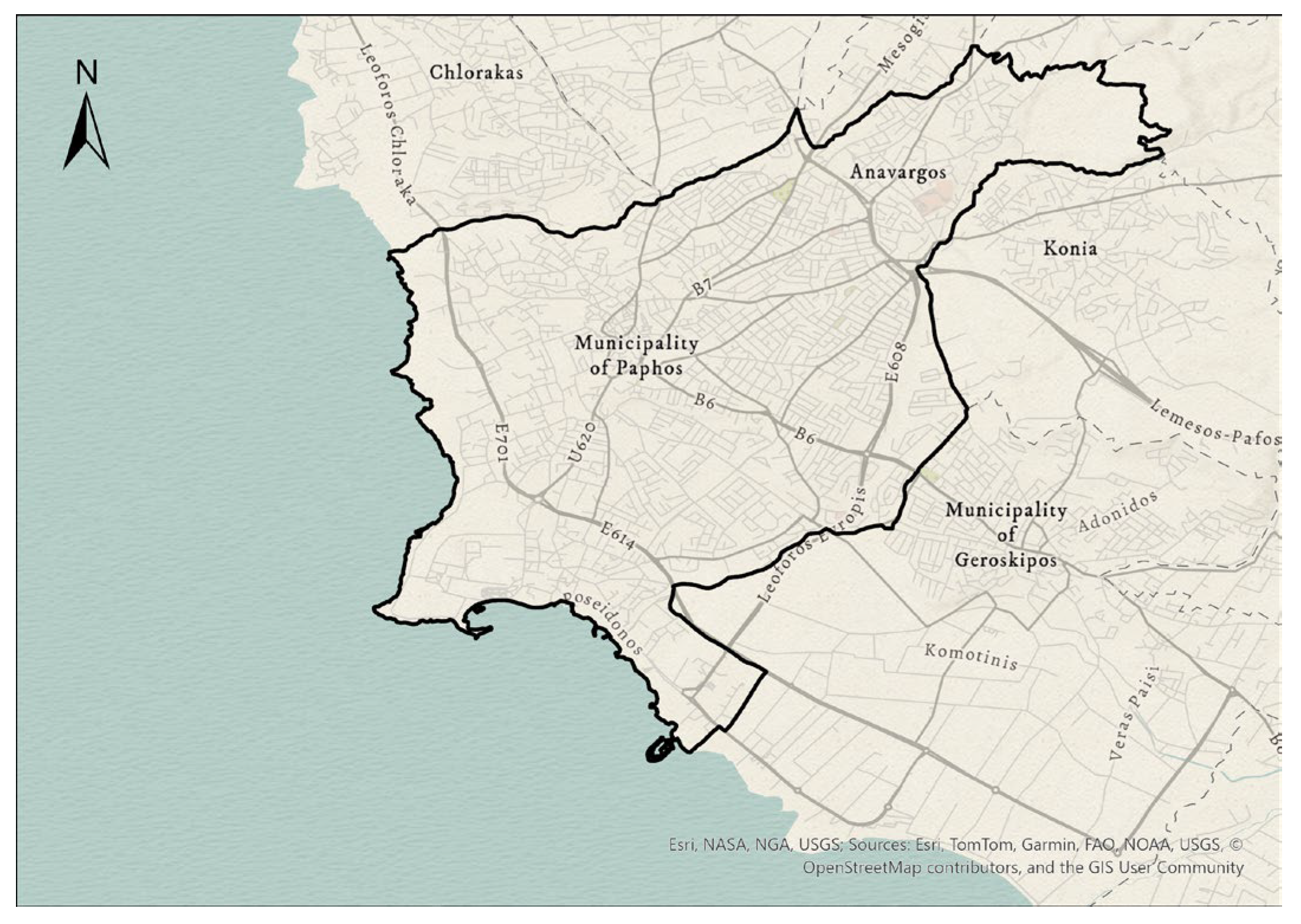
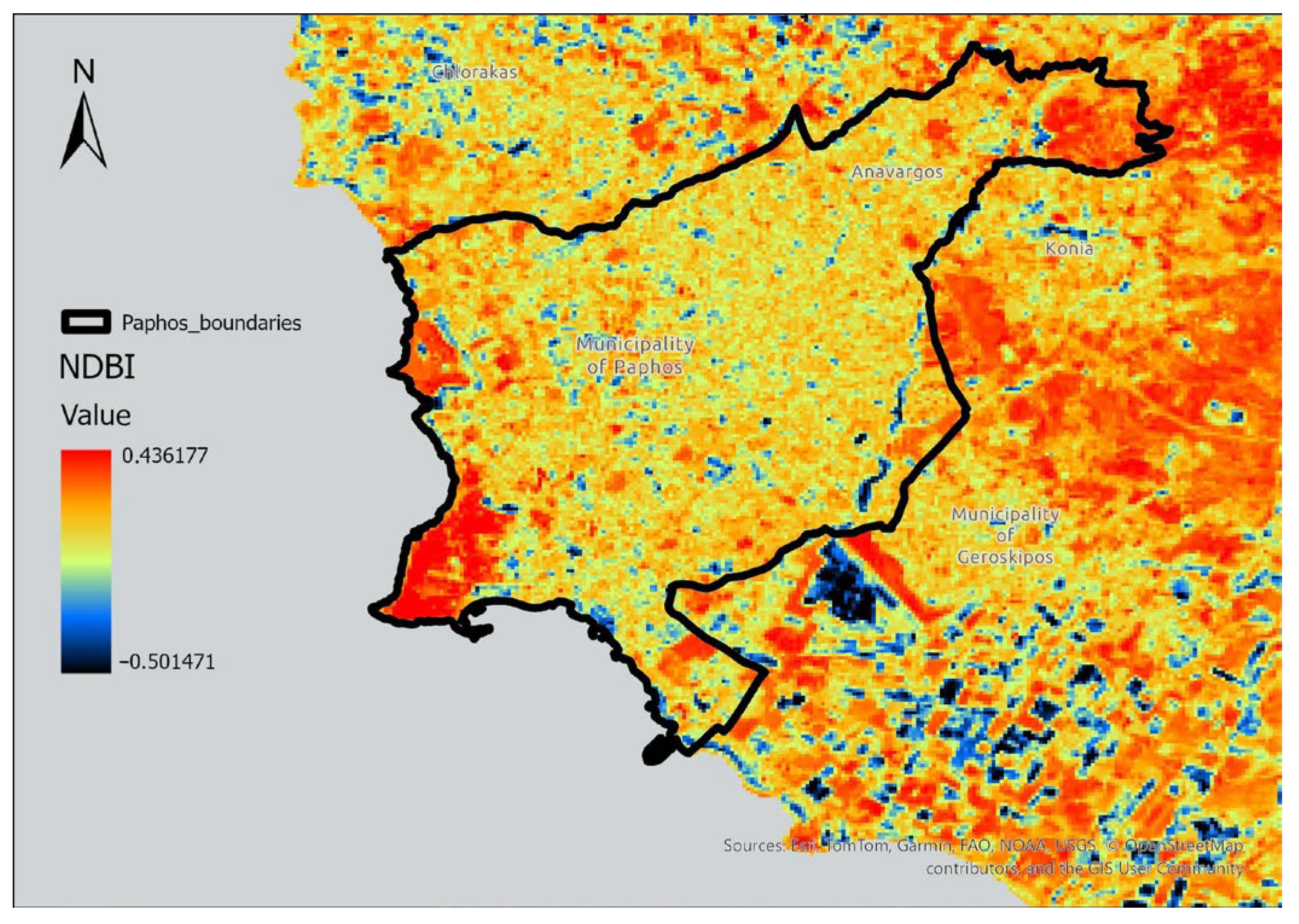
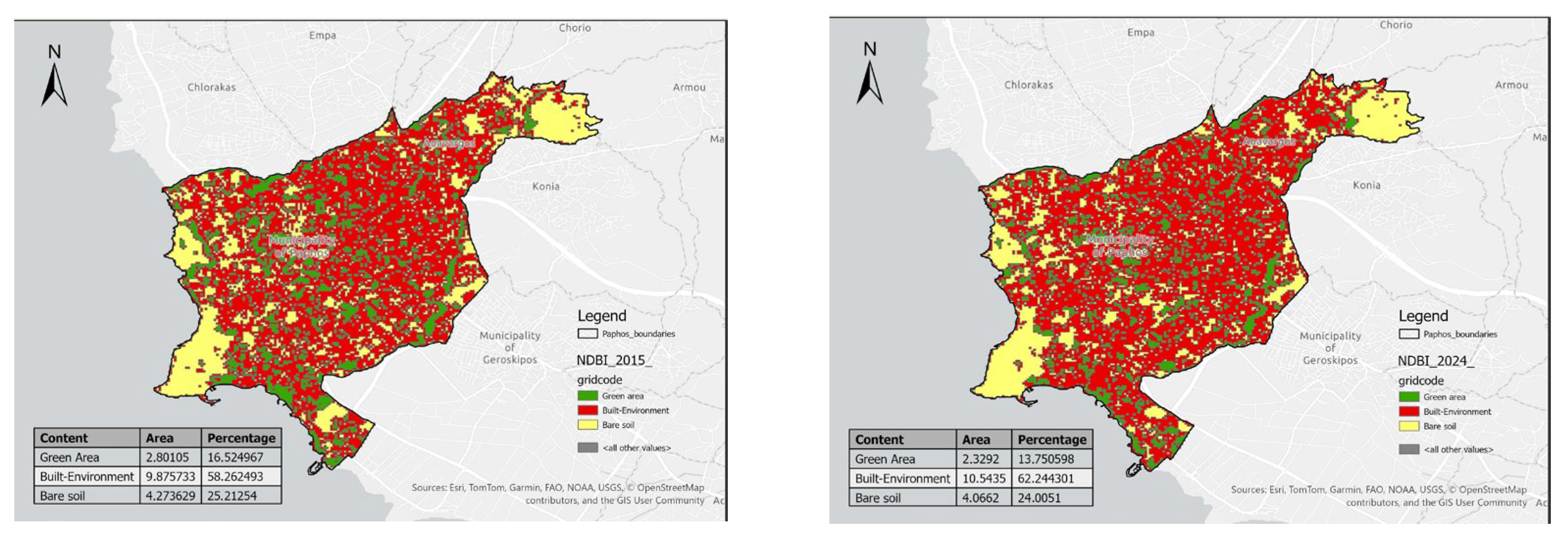
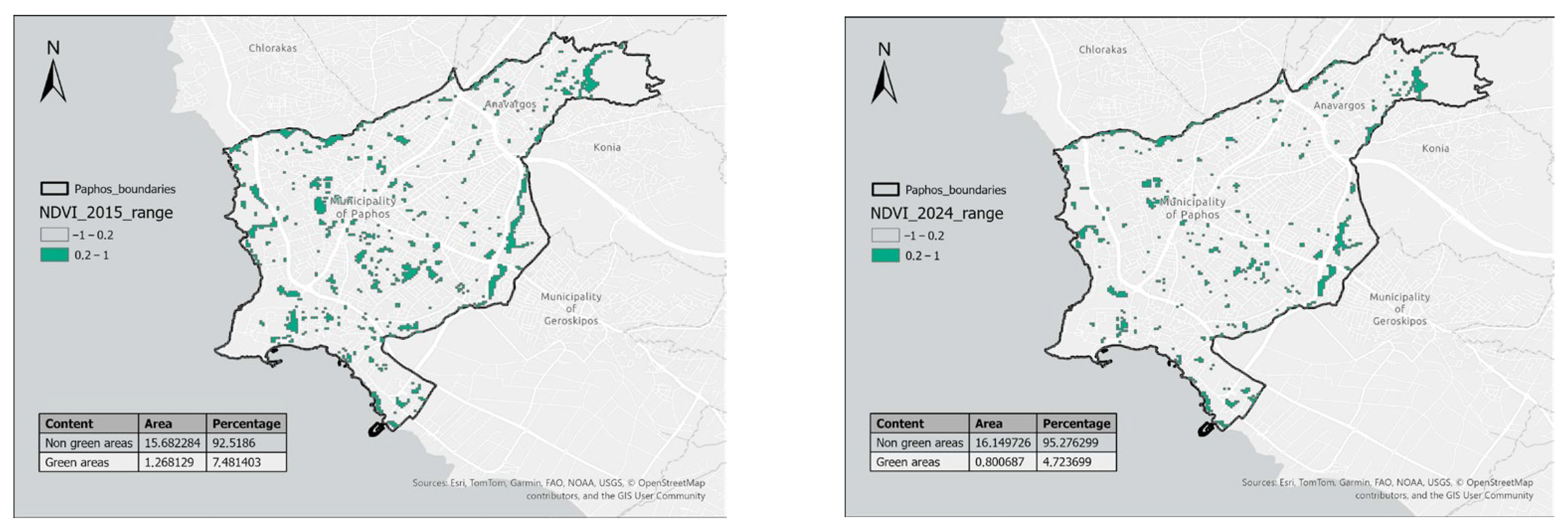
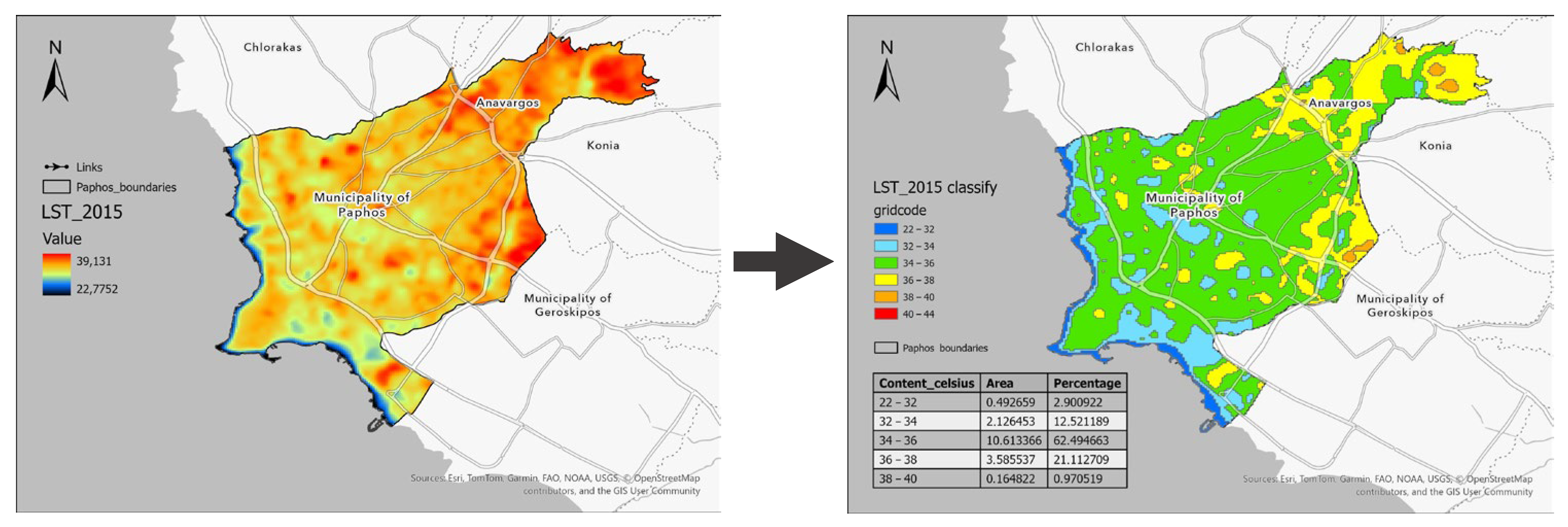
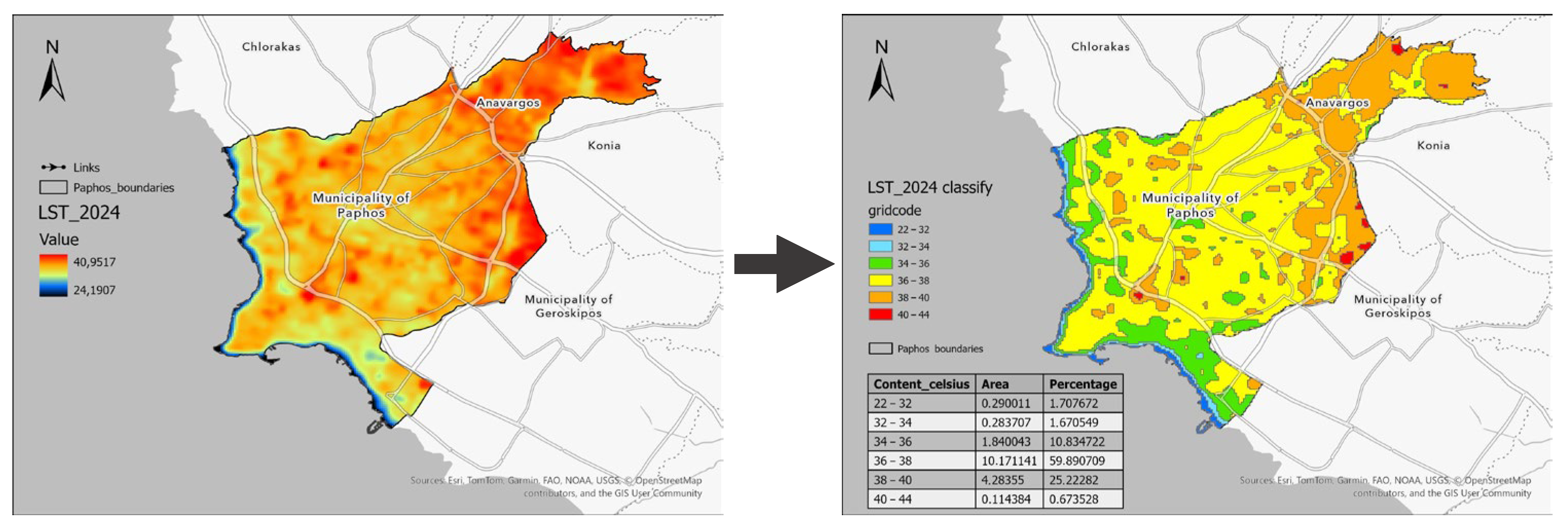
| 2015 | 2024 | |||
|---|---|---|---|---|
| Temperature Fluctuation (°C) | Area (m2) | Area (%) | Area (m2) | Area (%) |
| 22–32 | 0.49 | 2.9 | 0.29 | 1.70 |
| 32–34 | 2.12 | 12.52 | 0.28 | 1.67 |
| 34–36 | 10.61 | 62.49 | 1.84 | 10.83 |
| 36–38 | 3.58 | 21.11 | 10.17 | 59.89 |
| 38–40 | 0.16 | 0.97 | 4.28 | 25.22 |
| 40–44 | - | - | 0.11 | 0.67 |
Disclaimer/Publisher’s Note: The statements, opinions and data contained in all publications are solely those of the individual author(s) and contributor(s) and not of MDPI and/or the editor(s). MDPI and/or the editor(s) disclaim responsibility for any injury to people or property resulting from any ideas, methods, instructions or products referred to in the content. |
© 2025 by the authors. Licensee MDPI, Basel, Switzerland. This article is an open access article distributed under the terms and conditions of the Creative Commons Attribution (CC BY) license (https://creativecommons.org/licenses/by/4.0/).
Share and Cite
Dimitriou, C.; Michaelides, S.; Themistocleous, K.; Hadjimitsis, D.G.; Papadavid, G.; Gitas, I.; Kyriakides, N. Assessing the Urban Heat Island (UHI) Effect Using Land Surface Temperature (LST) and Normalized Difference Built-Up Index (NDBI): A Case Study on Paphos, Cyprus. Environ. Earth Sci. Proc. 2025, 35, 65. https://doi.org/10.3390/eesp2025035065
Dimitriou C, Michaelides S, Themistocleous K, Hadjimitsis DG, Papadavid G, Gitas I, Kyriakides N. Assessing the Urban Heat Island (UHI) Effect Using Land Surface Temperature (LST) and Normalized Difference Built-Up Index (NDBI): A Case Study on Paphos, Cyprus. Environmental and Earth Sciences Proceedings. 2025; 35(1):65. https://doi.org/10.3390/eesp2025035065
Chicago/Turabian StyleDimitriou, Christodoulos, Silas Michaelides, Kyriacos Themistocleous, Diofantos G. Hadjimitsis, George Papadavid, Ioannis Gitas, and Nicholas Kyriakides. 2025. "Assessing the Urban Heat Island (UHI) Effect Using Land Surface Temperature (LST) and Normalized Difference Built-Up Index (NDBI): A Case Study on Paphos, Cyprus" Environmental and Earth Sciences Proceedings 35, no. 1: 65. https://doi.org/10.3390/eesp2025035065
APA StyleDimitriou, C., Michaelides, S., Themistocleous, K., Hadjimitsis, D. G., Papadavid, G., Gitas, I., & Kyriakides, N. (2025). Assessing the Urban Heat Island (UHI) Effect Using Land Surface Temperature (LST) and Normalized Difference Built-Up Index (NDBI): A Case Study on Paphos, Cyprus. Environmental and Earth Sciences Proceedings, 35(1), 65. https://doi.org/10.3390/eesp2025035065








